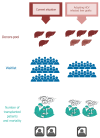Expanding the liver donor pool worldwide with hepatitis C infected livers, is it the time?
- PMID: 38947961
- PMCID: PMC11212581
- DOI: 10.5500/wjt.v14.i2.90382
Expanding the liver donor pool worldwide with hepatitis C infected livers, is it the time?
Abstract
Liver transplantation (LT) provides a life-saving option for cirrhotic patients with complications and hepatocellular carcinoma. Despite the increasing number of liver transplants performed each year, the number of LT candidates on the waitlist remains unchanged due to an imbalance between donor organ supply and the demand which increases the waitlist time and mortality. Living donor liver transplant had a great role in increasing the donor pool and shortened waitlist time for LT candidates. Nevertheless, further strategies can be implemented to increase the pool of potential donors in deceased donor LT, such as reducing the rate of organ discards. Utilizing hepatitis C virus (HCV) seropositive liver grafts is one of the expanded donor organ criteria. A yearly increase of hundreds of transplants is anticipated as a result of maximizing the utilization of HCV-positive organs for HCV-negative recipients. Direct-acting antiviral therapy's efficacy has revolutionized the treatment of HCV infection and the use of HCV-seropositive donors in transplantation. The American Society of Transplantation advises against performing transplants from HCV-infected liver donors (D+) into HCV-negative recipient (R-) unless under Institutional Review Board-approved study rules and with full informed consent of the knowledge gaps associated with such transplants. Proper selection of patients to be transplanted with HCV-infected grafts and confirming their access to direct-acting antivirals if needed is important. National and international consensuses are needed to regulate this process to ensure the maximum benefit and the least adverse events.
Keywords: Direct acting antivirals; Donor pool; Hepatitis C virus treated; Hepatitis C-viremic organs; Liver transplantation.; Non-viremic organs.
©The Author(s) 2024. Published by Baishideng Publishing Group Inc. All rights reserved.
Conflict of interest statement
Conflict-of-interest statement: We have no conflicts of interest to disclose.
Figures
References
-
- Terrault NA, Francoz C, Berenguer M, Charlton M, Heimbach J. Liver Transplantation 2023: Status Report, Current and Future Challenges. Clin Gastroenterol Hepatol. 2023;21:2150–2166. - PubMed
-
- United Network for Organ Sharing (UNOS) Data. UNOS Web site. Available from https://unos.org/data/
-
- Makhlouf N. Future Map of Liver Transplantation. Global Gastroenterol. 2023
Publication types
LinkOut - more resources
Full Text Sources


